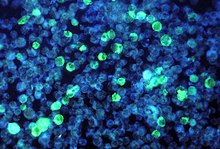Epstein–Barr virus infection
| Epstein–Barr virus infection | |
|---|---|
| Other names | Immunodeficiency 32B[1] |
| Specialty | Infectious diseases |
There are several forms of
Symptoms
Symptoms of
EBV also establishes a lifelong dormant infection in some cells of the body's immune system. A late event in a very few carriers of this virus is the emergence of Burkitt's lymphoma and nasopharyngeal carcinoma, two rare
Most individuals exposed to people with infectious mononucleosis have previously been infected with EBV and are not at risk for infectious mononucleosis. In addition, transmission of EBV requires intimate contact with the saliva (found in the mouth) of an infected person. Transmission of this virus through the air or blood does not normally occur. The incubation period, or the time from infection to appearance of symptoms, ranges from 2 to 6 weeks with 4 weeks being the most common. Persons with infectious mononucleosis may be able to spread the infection to others for a period of weeks. However, no special precautions or isolation procedures are recommended, since the virus is also found frequently in the saliva of healthy people. In fact, many healthy people can carry and spread the virus intermittently for life. These people are usually the primary reservoir for person-to-person transmission. For this reason, transmission of the virus is almost impossible to prevent.
The clinical diagnosis of infectious mononucleosis is suggested on the basis of the symptoms of fever, sore throat, swollen lymph glands, and the age of the patient. Usually, laboratory tests are needed for confirmation. Blood test results for persons with infectious mononucleosis include an elevated white blood cell count, an increased percentage of atypical mononuclear cells. Liver enzymes are often elevated. A positive "mono spot" test is useful in confirming the diagnosis but a negative result does not rule out primary EBV infection.
EBV-associated diseases
- Chronic active EBV infection
- Epstein–Barr virus-associated lymphoproliferative diseases
- Hodgkin's disease
- Acute kidney injury[10]
- Alice in Wonderland syndrome
- Common variable immunodeficiency (CVID)
- Hairy leukoplakia
- Hepatitis
- Herpangina
- Infectious mononucleosis
- Kikuchi's disease
- Multiple sclerosis (higher risk in patients infected as teenagers than as children)
- Nasopharyngeal cancer
- Several Burkitt's lymphomaand primary cerebral lymphoma
- Post-transplant lymphoproliferative disorder
- Smooth muscle tumors[11]
- Stevens–Johnson syndrome
- Subepithelial Infiltrates
- New daily persistent headache (NDPH)
Since EBV is present in most adults, then most adult diseases can be "associated" with EBV. However, since "association" is not "causation" (http://rafalab.dfci.harvard.edu/dsbook/association-is-not-causation.html), this list long list need not be of great concern.
Pathology
Infectious mononucleosis
Epstein–Barr can cause infectious mononucleosis, also known as 'glandular fever', 'mono' and 'Pfeiffer's disease'. Infectious mononucleosis is caused when a person is first exposed to the virus during or after adolescence. It is predominantly found in the developing world, and most children in the developing world are found to have already been infected by around 18 months of age. Infection of children can occur when adults mouth feed or pre-chew food before giving it to the child.[12] EBV antibody tests turn up almost universally positive. In the United States roughly half of five-year-olds have been infected.[13]
EBV-associated malignancies

The strongest evidence linking EBV and cancer formation is found in
Other B cell lymphomas arise in immunocompromised patients such as those with
Diagnosis
EBV can be diagnosed through a
Treatment
There is no specific treatment for infectious mononucleosis, other than treating the symptoms. In severe cases, steroids such as
It is important to note that symptoms related to infectious mononucleosis caused by EBV infection seldom last for more than 4 months. When such an illness lasts more than 6 months, it is frequently called chronic EBV infection. However, valid laboratory evidence for continued active EBV infection is seldom found in these patients. The illness should be investigated further to determine if it meets the criteria for
See also
References
- ^ "IMMUNODEFICIENCY 32B; IMD32B". OMIM. OMIM.org. Retrieved 19 March 2019.
- S2CID 47010934.
- PMID 29631196.
- PMID 27723397.
- PMID 26424654.
- PMID 28116304.
- S2CID 22942874.
- ^
Fleisher, G.; Bolognese, R. (1983). "Persistent Epstein–Barr virus infection and pregnancy". PMID 6304207.
- National Center for Infectious Diseases. 16 May 2006. Archived from the originalon 20 April 2012. Retrieved 2008-10-05.
- ^
Tsai, JD; Lee, HC; Lin, CC; Liang, DC; Chen, SH; Huang, FY (2003). "Epstein–Barr virus-associated acute renal failure: diagnosis, treatment, and follow-up". S2CID 24164770.
- ^
Deyrup, Andrea T; Lee, Victor K; Hill, Charles E; Cheuk, Wah; Toh, Han Chong; Kesavan, Sittampalam; Chan, Errol Wei??en; Weiss, Sharon W (2006). "Epstein–Barr virus-associated smooth muscle tumors are distinctive mesenchymal tumors reflecting multiple infection events: A clinicopathologic and molecular analysis of 29 tumors from 19 patients". S2CID 35268948.
- PMID 19350698.
- ^ Bennett, NJ (12 October 2008). "Mononucleosis and Epstein–Barr Virus Infection". eMedicine. Retrieved 2008-10-05.
- PMID 25364378.
- ^
Lerner, AM; Beqaj, SH; Deeter, RG; Fitzgerald, JT (2004). "IgM serum antibodies to Epstein–Barr virus are uniquely present in a subset of patients with the chronic fatigue syndrome". PMID 15113035.
- ^
Lünemann, Jan D.; Münz, Christian (2007). "Epstein–Barr virus and multiple sclerosis". S2CID 20534047.
- ^ "Burkitt lymphoma". MedlinePlus. Retrieved 2012-04-10.
- ^
Weiss, Sharon W. (2002). "Smooth muscle tumors of soft tissue". S2CID 45276404.
- ^ "Nasopharyngeal Cancer". HealthCommunities.com. 7 December 2011.
- ^ "Epstein-barr | Mononucleosis | About Virus | Mono | CDC". www.cdc.gov. 2019-01-28. Retrieved 2020-09-12.
- PMID 27337443.
